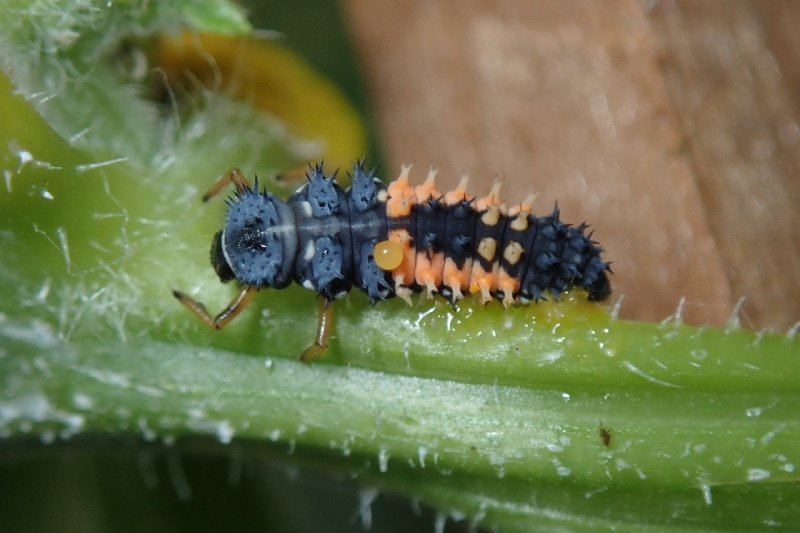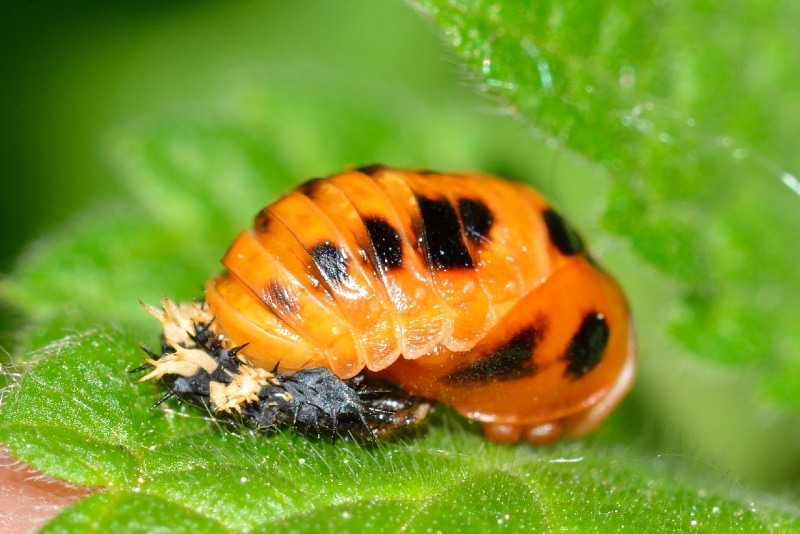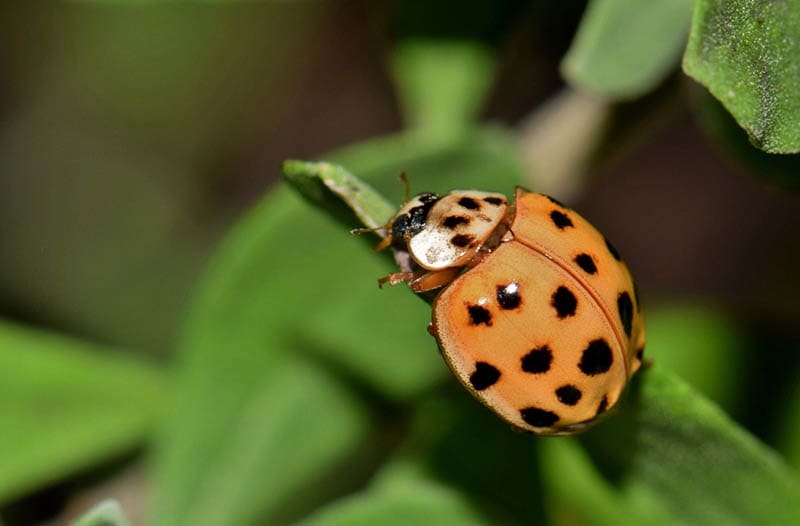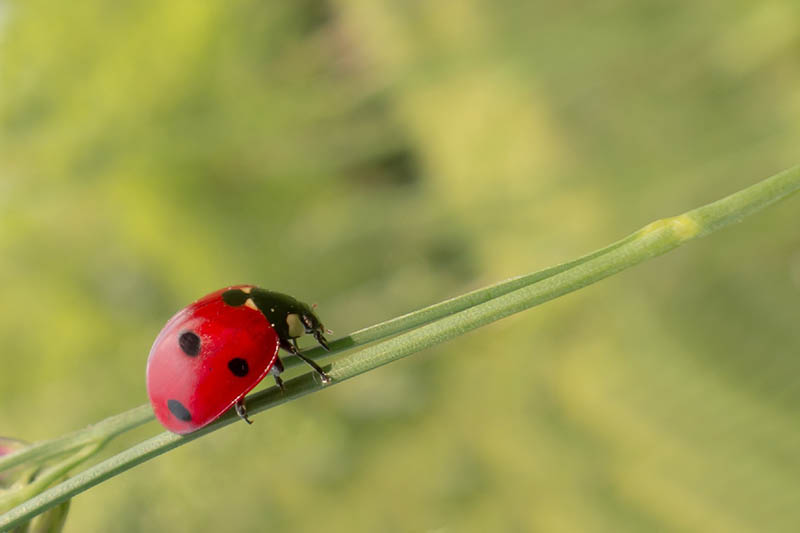How Long Do Ladybugs Live? 4 Life Stages (With Pictures)
-
Pete Ortiz
- Last updated:

Ladybugs are a joy forever, but how long do they live? These insects live for about a year as adults. But before that, they undergo a four-stage growth process known as complete metamorphosis.
Stick around to learn more about a ladybug’s life cycle. But first, did you know they are not bugs, as their name suggests?
They belong to the “Coccinellidae” family of beetles under the “Insecta” class in the biological animal kingdom classification. Ladybugs, otherwise known as lady beetles or ladybirds, also don’t have the proboscis, a beak-like sucking mouthpart, a key physical characteristic that true bugs possess.
The 4 Life Stages of a Ladybug
1. Embryonic (Egg) Stage

A ladybird’s life cycle begins at this stage. Typically, ladybugs reproduce sexually. After fertilization, a female ladybird lays eggs in groups of 5–50 in a single area.
The location where female ladybugs lay their eggs depends on factors such as the availability of food and the likelihood of being found by their predators. Usually, they lay their eggs on plant leaves with an abundance of aphids, so the larvae will have enough food once they emerge from their eggs.
Ladybird eggs are yellow and have an oblong shape, like yellow jelly beans, except they are tiny. These eggs take about 2–10 days to hatch. Those that don’t hatch serve as a backup food source for the larvae if the available food (aphids) is in limited supply.
2. Larval (Larvae) Stage

Around 2–10 days after a female ladybug lays its eggs, most of them hatch into larvae. Factors such as the species and the environmental temperatures affect how long it takes before the eggs hatch.
During this stage, a ladybug larva can consume up to 400 aphids (which is way more than what an adult ladybug consumes) before pupating. They also eat other soft-bodied plant pests, such as mites, adelgids, and even eggs that didn’t hatch.
It takes about two weeks before a lady beetle larva pupates. During this period, the larva goes through four developmental stages known as instars. In its first instar, the larva eats until it’s too big for its cuticle and then molts.
It does the same in its second and third instars. In its fourth instar, it attaches itself to a leaf or any other suitable surface before it pupates.
3. Pupal (Pupa) Stage

The pupal stage lasts about two weeks, and ladybugs are inactive throughout this period. During this stage, their bodies undergo drastic changes controlled by cells known as histoblasts. These are specialized cells that control the biochemical process that involves the breaking down of a lady beetle larva’s body, transforming it into an adult ladybird.
A ladybug’s pupa usually develops with its head facing upwards. The tissues begin developing, then after about a week, its skin starts splitting down its back, and finally, an adult ladybug appears.
4. Adult Stage

Newly emerged adult lady beetles have soft exoskeletons, making them easy prey for their predators until their bodies fully develop. Their bodies are normally pale and yellow, but as time goes by, they develop those bright colors and attractive spots they are famously known for.
Adult ladybirds live for about a year, although this depends on factors such as environmental temperatures and the presence of predators.
FAQ
Do Ladybugs Hibernate?
Similar to many insects, lady beetles are ectothermic, meaning they cannot control their body temperature in relation to their environment. So, during winter, they become dormant or hibernate.
So, does hibernation increase a ladybug’s lifespan? In a way, yes, it does. During hibernation, most of their bodily activities, such as breathing, reduce, which helps them preserve the energy to survive through the winter season.
How Long Do Ladybugs Live Without Food?

Ladybugs can live for about 10–20 weeks without food (which is when they hibernate), thanks to the fat reserves in their bodies. When ladybirds are active, they eat a lot, and a good amount of that food is used to build up fat reserves in their bodies for when they hibernate.
Once they begin to hibernate, they can survive without feeding for as long as the fat reserves in their bodies last. When these reserves are all used up, and the ladybird doesn’t actively feed, it can only last for about two days.
How Long Do Ladybugs Live Indoors?
If you want to keep ladybugs as pets, you may wonder how long they can live indoors. The good news is they can live throughout their average lifespan (a year) if you provide them with the right living conditions.
For starters, begin by creating a suitable living environment for your lady beetles. You can use any spacious container as their habitat. Create several holes around the container to ensure it is well-ventilated but not too big so the ladybirds can escape. You can also add some twigs, small plants, and even rocks to mimic their natural habitat.
When it comes to food, there are many things you can feed your lady beetles, such as water-sugar solutions and raisins. However, to ensure they live long, it’s best to feed them their natural food, which is mainly aphids and small insects like mealy bugs.
Ladybugs may not live to adulthood if they don’t feed on their natural prey. What’s more, female ladybirds may not lay many viable eggs if they don’t consume their natural food.
Finding aphids is pretty easy. All you have to do is access a place where ladybirds are in abundance, like a garden or a park, because chances are there are aphids in that area. Then, pluck the leaves or stems with aphids and place them in the container with your ladybirds.
You’ll find mealybugs on flowers and fruit-bearing plants like papaya and grapes.
In regards to temperature and humidity, lady beetles thrive at room temperature. As for humidity, ladybirds prefer moist areas, so it’s advisable to keep the container moist.
Final Thoughts
As you may have noticed, ladybirds live beyond one year if you include the time they spend in the first three developmental stages. However, their average lifespan is still a year since most of them may not survive for long as adults due to factors like predators and unsuitable environmental conditions.
There are several myths you may have heard (or believed) in regard to a ladybird’s age and lifespan. The most common one is that people can tell how a ladybug is by counting its spots. Well, this isn’t true.
For starters, there’s no way to tell a ladybird’s age. The spots, together with the bright colors on their bodies, are actually one of their defense mechanisms against their predators. Scientifically known as aposematic coloring, the black spots mixed with the bright colors on their bodies are a warning sign to their predators that they are toxic if eaten.
Featured Image Credit: cocoparisienne, Pixabay
Contents



